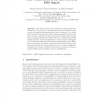Free Online Productivity Tools
i2Speak
i2Symbol
i2OCR
iTex2Img
iWeb2Print
iWeb2Shot
i2Type
iPdf2Split
iPdf2Merge
i2Bopomofo
i2Arabic
i2Style
i2Image
i2PDF
iLatex2Rtf
Sci2ools
AIIA
2007
Springer
2007
Springer
A 3D Virtual Model of the Knee Driven by EMG Signals
A 3D virtual model of the human lower extremity has been developed for the purpose of examining how the neuromuscular system controls the muscles and generates the desired movement. Our virtual knee currently incorporates the major muscles spanning the knee joint and it is used to estimate the knee joint moment. Beside that we developed a graphical interface that allows the user to visualize the skeletal geometry and the movements imparted to it. The purpose of this paper is to describe the design objectives and the implementation of our EMGdriven virtual knee. We finally compared the virtual knee behavior with the torque performed by the test subject in order to obtain a qualitative validation of our model. Within the next future our aim is to develop a real-time EMG-driven exoskeleton for knee rehabilitation.
| Added | 07 Jun 2010 |
| Updated | 07 Jun 2010 |
| Type | Conference |
| Year | 2007 |
| Where | AIIA |
| Authors | Massimo Sartori, Gaetano Chemello, Enrico Pagello |
Comments (0)

